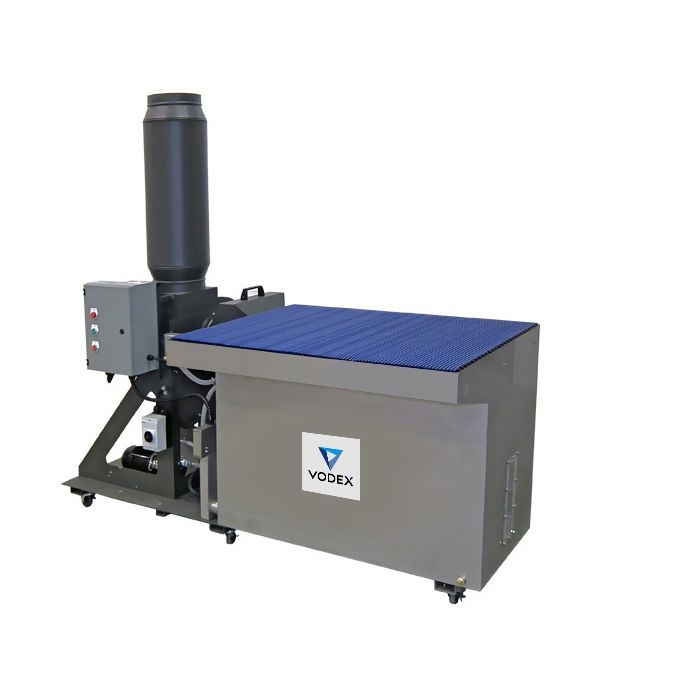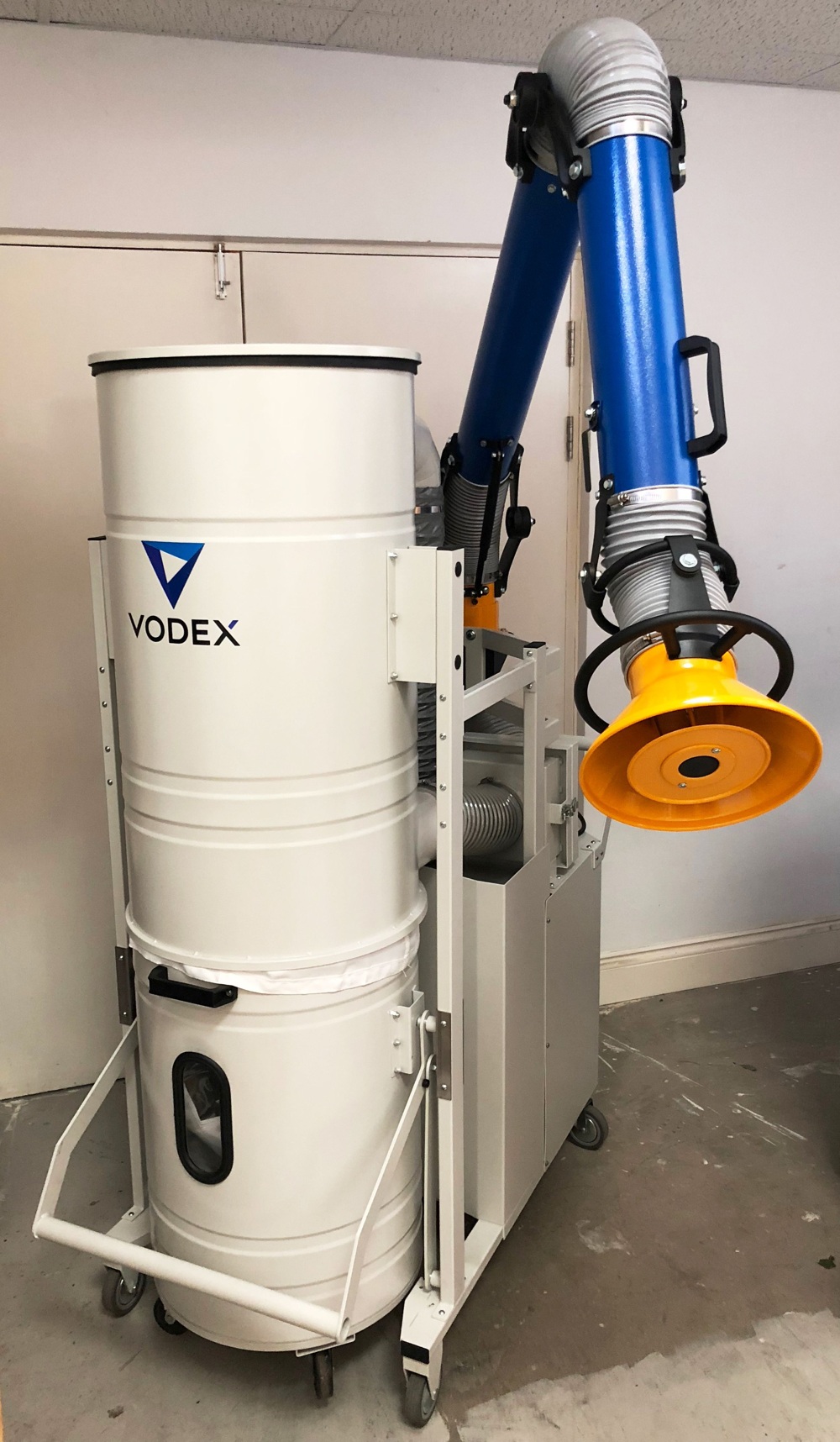How best to bust the dust

Paul Riddick, co-founder and technical director at fume and dust extraction specialists, Vodex looks at how best to remove dust to protect workers and aircraft.
Statistics released by the International Air Transport Association show that only 2% of carbon dioxide production can be laid at the door of the air travel industry; a fraction of that produced by road transportation or by farming. Focusing on CO2 has overshadowed concerns about other forms of air pollution that are better grounded in science, easier to remedy and more economically significant for aerospace industries.
Aerospace enterprises are multifaceted. Air quality issues are a major concern for passengers and cabin crews, in the operation of airports and throughout the entire array of component manufacturing and maintenance supply lines. Each of these environments poses a variety of air quality challenges, but none more so than the diverse and quality-critical operations conducted in hangars and workshops.
Gaseous pollutants with more immediate implications than CO2 include ozone, nitrogen oxides, sulphur dioxide, methane, carbon monoxide, and countless volatile organics (VOCs). These come from the use of paints, special coatings, chemical strippers, cleaning fluids, adhesives, sealants, milling maskants, de-icing fluids, pesticides, oils and oil additives such as tricresylphosphates (TCPs). Issues even ensue from the fumes generated by laser and 3D printers.
Yet the greatest damage is almost certainly caused by dust. Dust causes damage by three means: it ruins the finish and quality standards of many procedures involved in component production and safety-critical maintenance; it accelerates the rate of wear of aircraft components, workshop tools and ancillary vehicles; and it carries toxic airborne chemicals in ways that pose dangers to workers, passengers, local neighbourhoods and the environment at large. Comprehensive dust extraction strategies are a better way to ameliorate these hazards than a piecemeal approach.

Identifying all the risks
Dust is a vague term with many components. The chief issue of concern for aerospace industries is airborne ‘particulates’ created by industrial processes and engine emissions. While there are dozens of potentially harmful vapours, there are thousands of potentially toxic chemicals carried in particulates. Many are created in the course of welding, milling and combustion. Dust is always a more complex soup than the materials from which it was generated.
Particulates also pose different hazards according to their size and density. Particles over 100µm pose hazards, but are unlikely to be inhaled; particles of 30-100µm are easily inhaled but unlikely to penetrate the lungs, while particles of less than 30µm are deemed ‘respirable’. Consequently, particle size can merit a different extraction technology, even when worked materials have the same chemical composition.
Small particulates are easier to breathe in than to breathe out. As a result, they accumulate in the lung and have plenty of time to provoke allergies, asthma, lung-scarring, cancer and autoimmune diseases. The smallest even cross the lung wall and enter the bloodstream, thus reaching every organ. Fine particulates also stay airborne long enough to reach deeper into the narrowest recesses of machinery and electronics.
Dust doesn’t become any less hazardous when it is allowed to accumulate on the ground, or on roof joists, or as a fine film that coats even vertical surfaces. Without remedial measures, particulates settle at varying distances from their point of emission and continue to present risks to aircraft and equipment; as well as to people by skin contact, ingestion or groundwater contamination. It is simply a matter of time until it becomes airborne again.
The HR costs of occupational diseases are high, especially for an industry where personnel are highly-skilled and hard to replace. Released into the wider area, poor air quality affects personnel far from the point where pollutants are initially released. Inhalation of fumes and particulates needn’t proceed to an occupational disease before it begins to take a toll by causing general fatigue, headaches and lower resistance to opportunist infections. The result is reduced productivity, increased absenteeism, accelerated staff turnover and the high costs of training replacements.

Protecting aircraft finishes
Aircraft finishes need to endure extremes of temperature and weather, as well as vibration and flexing. Impurities embedded into any of the layers that coat a fuselage or protect internal components will shorten their lifespan, raising long-term maintenance costs. Both in workshops and on production lines, contamination of painted surfaces is a common cause of quality rejection, leading to additional stripping, grinding and spraying. As well as wasting time and money, these additional operations themselves add to the emissions and energy consumption of the operation.
When feasible, fume and dust capture at source is frequently the most desirable solution. In many cases, this consists of a vacuum line attached directly to the tooling. For example, suction lines attached to soldering wands are common in the electronics industry. Without them, the complex fumes released by solders, fluxes and components pose a significant hazard and impair the abilities of production personnel to concentrate efficiently throughout a shift. Sanders, milling and drilling equipment can be similarly equipped, although fume and dust extraction equipment becomes more cumbersome as the scale of an operation increases.
Hoods and ducts provide a more suitable extraction technology for larger equipment, work areas and test bays. These can still be designed to focus specifically on sources of fumes, particulates or dust. For example, a Local Exhaust Ventilation (LEV) system may consist of extractors mounted on flexible arms. Air-benches are another tactic, using gentle downdrafts to pull emissions into collecting grilles.
Different solutions may be needed for material preparation, collection or storage areas: for example, to suppress dust generated by the delivery or weighing out of a powdered product. Air quality specialists such as Vodex term this ‘supplied’ as opposed to ‘process-generated’ dust.
A third level of protection can be provided by macro-scaled ventilation systems that monitor and maintain air quality throughout an entire area, room or hangar.
Collection points are only one element in extraction systems. There are also decisions to be made as to how fumes and particles are disposed of. For the least hazardous operations, it can be sufficient just to direct contaminants away from the operator's face (the helmets used in airline shot-blasting would fall into this category). Usually, however it is necessary to vent waste air from the building or to filter it in a variety of ways, or do both.
‘Extraction’ in the full sense involves everything from identifying or sensing the pollutant, capturing it (through hoods, arms, ducts), cleaning and filtering (using grills, HEPA filters, activated charcoal or chemical processes), disposal of the pollutant (for example filter removal or cleaning routines) and venting or return of safe air. Depending on the space, it may (or may not) be cost-effective to integrate air quality controls into a complete HVAC system.
Designing cost-effective solutions requires a clear understanding of the specific hazards, the filtering and extraction technology options available and anticipation of side-issues that could arise, including noise remediation measures.
Not least, air quality specialists bring with them a full understanding of current UK, EU and international environmental and workplace legislation which is particularly valuable in these politically transitional times.













